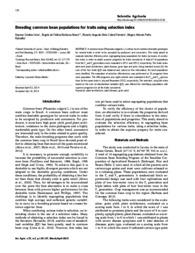Breeding common bean populations for traits using selection index.
Breeding common bean populations for traits using selection index.
Author(s): LIMA, D. C.; ABREU, A. de F. B.; FERREIRA, R. A. D. C.; RAMALHO, M. A. P.
Summary: A common bean (Phaseolus vulgaris L.) cultivar must combine desirable genotypes for several traits in order to be accepted by producers and consumers. This study aimed to evaluate selection efficiency when segregating bean populations for traits, by means of a selection index, in order to obtain superior progenies for traits considered. A total of 16 populations from the F4 and F5 generations were evaluated in 2011 and 2012, respectively. The traits evaluated were plant architecture, plant disease, grain type and yield. Using standard scores (Z), the sum of the four traits (ΣZ) was obtained and, based on this information, the best populations were identified. The evaluation of selection effectiveness was performed on 31 progenies from each population. The 496 progenies plus eight controls were evaluated in the F5:6 and F5:7 generations for the same traits in July and November 2012, respectively. The selection, using the index based on the sum of standardized variables (ΣZ), was efficient for identifying populations with superior progenies for all the traits considered.
Publication year: 2015
Types of publication: Journal article
Unit: Embrapa Rice & Beans
Observation
Some of Embrapa's publications are published as ePub files. To read them, use or download one of the following free software options to your computer or mobile device. Android: Google Play Books; IOS: iBooks; Windows and Linux: Calibre.
Access other publications
Access the Agricultural Research Database (BDPA) to consult Embrapa's full library collection and records.
Visit Embrapa Bookstore to purchase books and other publications sold by Embrapa.

